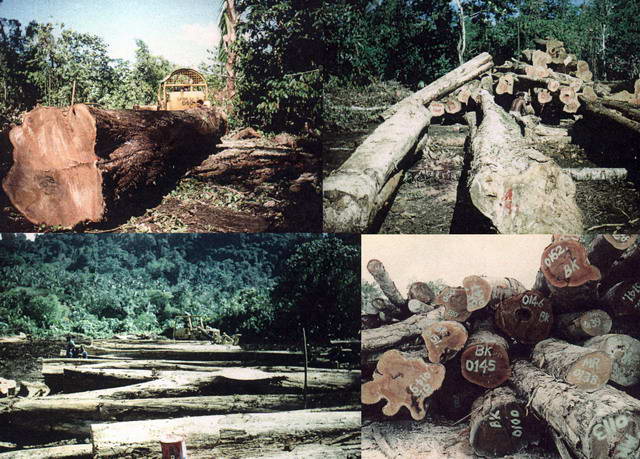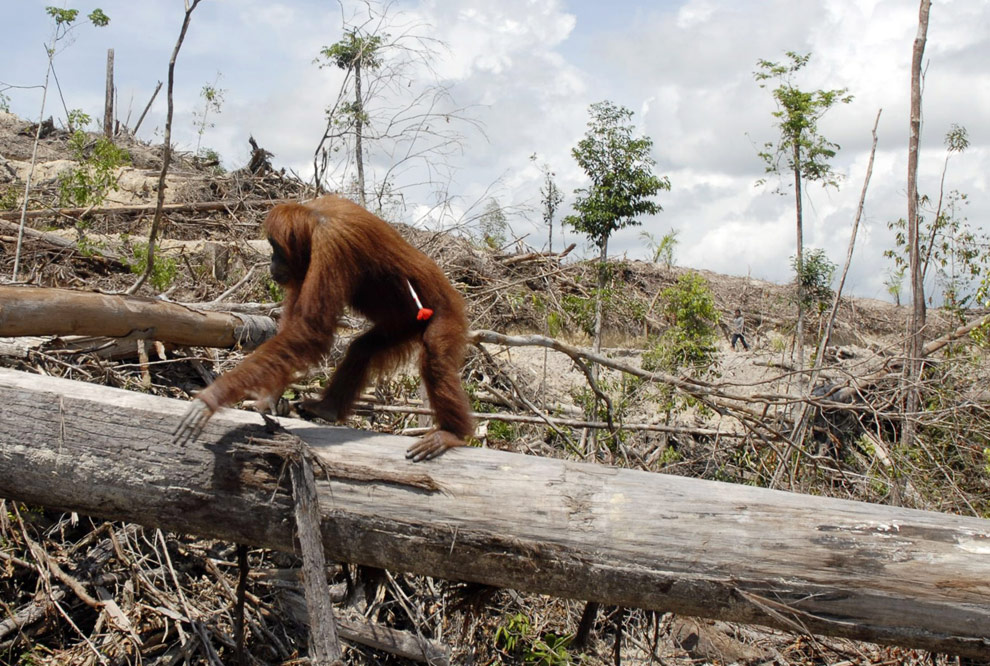By
David SmithA shocking UN report details how the booming palm oil industry is wiping out one of man's closest relatives as its forest habitat disappears. David Smith asks if it's too late to save them

The Orang Utan, one of man's closest and most enigmatic cousins, could be virtually extinct within five years after it was discovered that the animal's rainforest habitat is being destroyed even more rapidly than had been predicted.
A United Nations report has found that illegal logging and fires have been overtaken as the primary cause of deforestation by a huge expansion of oil palm plantations, which are racing to meet soaring demand from Western food manufacturers and the European Union's zeal for biofuels.
Palm oil is seen by critics as a cautionary tale about good intentions. As a vegetable oil it can enhance a healthy diet, and as a biofuel it can reduce carbon emissions which contribute to climate change. Yet it transpires that humans' pursuit of an ethical lifestyle could inadvertently mean a death sentence for one of the great apes.
The paradox was brought to world attention by Friends of the Earth, whose ongoing campaign for producers, manufacturers and retailers to commit to sustainable palm oil was recognised at last week's Observer Food Monthly awards with the honour for best ethical contribution to the industry.
The UN's environment programme report, 'The Last Stand of the Orang Utan: State of Emergency', says natural rainforests of Indonesia and Malaysia are being cleared so rapidly that up to 98 per cent may be destroyed by 2022, and the lowland forest strongholds of orang utans much sooner, unless urgent action is taken. This is a full decade earlier than the previous report estimated when it was published five years ago. Overall the loss of orang utan habitat is happening 30 per cent more rapidly than had previously been thought.
Responding to the findings, the Borneo Orang Utan Survival Foundation UK, a charity which works to rescue, rehabilitate and release the animals into protected forest, warned that at the current rate of deforestation by the palm oil industry, orang utans in the wild could be close to extinction by 2012.
Sir David Attenborough, the broadcaster and naturalist, told The Observer: 'Every bit of the rainforest that is knocked down is less space for orangs. They have been reduced very seriously in the past decade. Western governments and companies need to be proactive.'
Satellite images reveal that illegal logging is now taking place in 37 out of 41 national parks in Indonesia and is probably still on the increase. The report says: 'At current rates of intrusions, it is likely that some parks may become severely degraded in as little as three to five years, that is by 2012.'
The UN also highlights the growing threat posed by palm oil harvesting, noting that large areas of Indonesian and Malaysian forest have been cleared to make way for plantations. As consumer awareness about healthy eating and ethical shopping grows, palm oil is an increasingly popular alternative to trans fatty acids - more closely associated with heart disease - and is found in one in 10 supermarket products including margarine, baked goods and sweets, as well as detergents and lipsticks.
There has been much soul searching among environmentalists because palm oil is also in demand for biofuels, seen as one of the best ways of reducing dependence on fossil fuels and so combating global warming. Palm oil is currently considered the most productive source of biodiesel fuel, and Indonesia and Malaysia account for 83 per cent of its global production.
Since 2003 the European Union has been among the chief culprits. Its biofuels progress report earlier this year specified Indonesia among the list of countries for cheap biofuel production, prompting Greenpeace to warn: 'Booming EU demand for biofuels could kill Indonesian forests.' Britain imports one million tonnes every year, double what it did in 1995.
But the new UN report warns: 'Today, the rapid increase in [oil palm] plantation acreage is one of the greatest threats to orang utans and the forests on which they depend. In Malaysia and Indonesia, it is now the primary cause of permanent rainforest loss. The huge demand for this versatile product makes it very difficult to curb the spread of plantations.'
Displaced from their rainforest habitat, the orang utans struggle to survive in the oil palm plantations and are regarded as an agricultural pest. Mindful of the potential loss in profits, farmers have carried out a vicious extermination programme.
Michelle Desilets, director of the Borneo Orang Utan Survival Foundation UK, said: 'They are left hungry so they go in search of food in the plantations and destroy the plants. They become easy targets. Some plantation owners put a bounty of $10 or $20 on the head of orangutans, which is worth a few weeks' salary for the workers.
'Workers don't usually have guns: the orang utans that get shot are the lucky ones. We've seen them beaten to death with wood sticks or iron bars, doused in petrol and set on fire, trussed up in nets or tied up with wire which cuts through their flesh. Often a mother is killed and eaten while its baby is sold on or kept as a pet. In the local plantations where we're working, the managers have now agreed not to offer the bonus. But there's still a macho thing about bringing down an adult male.'
The foundation's struggle to save the animals will be shown in the series Orang Utan Diary starting on BBC2 on 2 April. Desilets said that the palm oil industry was now a severe threat to orang utans' very existence. 'The plantations are huge, the size of a county in England: you can drive for two hours and you're still in one. In the UK, when a product says "vegetable oil" it might mean palm oil, so you're not aware that you might be party to this killing. We put the functional survival of orang utans in the wild at no more than five years. There will always be some remote pockets but the population will be too small to reproduce and in one or two generations it will die out. When the last orang utan dies I will give up all hope in humanity. But for the time being we still have hope.'
Campaigners will move up a gear this week. Hardi Baktiantoro, director of Indonesia's Centre for Orang Utan Protection, has flown to Britain to work with the group Nature Alert to push for greater accountability. He said: 'With my own hands I have rescued countless baby orang utans orphaned by palm oil companies. With my eyes I have witnessed these same companies extinguish all natural life where pristine rainforests once stood. The situation is so desperate in Indonesia that I have come to Great Britain to ask for help with introducing Orang Utan Friendly palm oil into food and other household products.'
After a year of hard campaigning, including demonstrations outside stores, Friends of the Earth persuaded Tesco and other supermarkets to work with producers and manufacturers on a scheme for certifying sustainable palm oil which should include labelling products so consumers can be sure they are not buying from a source which harms orang utans.
Supermarkets said they were trying to tackle the issue although they have been criticised for moving too slowly. A spokesman for Tesco said: 'We are deeply concerned about the loss of rainforest - and the orang utans it supports - and believe that we can make a real contribution to work on this important area. It is a complex problem.'
Sean Sutcliffe, chief executive of the Biofuels Corporation, the biggest biofuels company in the UK, said: 'The existing deforestation is driven by demand from food and cosmetics. Palm oil should be part of the solution: the key is to make sure that standards are put in place.'
Adapted from Guardian.co.uk
 photo: chem7 via flickr
photo: chem7 via flickr




















